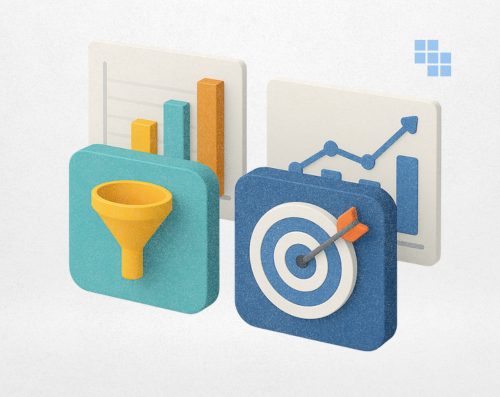Dive deep into enterprise analytics. Explore industry trends & practical strategies to unlock data-driven decision making.
What is enterprise analytics?
Enterprise data analytics refers to the systematic approach of collecting, processing, and analyzing data to gain insights that drive business decisions. Unlike traditional data analysis, which might focus on specific projects or departments, enterprise data analytics encompasses a holistic view across an organization. This integrated approach ensures that data from various sources is consolidated, cleaned, and analyzed to provide a comprehensive understanding of business performance.
In an era where data is considered the new oil, leveraging analytics is not just about understanding past performance but also about predicting future trends and making proactive decisions. Enterprise data analytics enables organizations to optimize operations, enhance customer experiences, and innovate continuously.
Key components of enterprise data analytics
- Data collection
The foundation of effective data analytics is robust data collection. This process involves gathering data from a variety of sources, including:
- Internal sources: Operational systems, CRM platforms, ERP systems, and internal databases.
- External sources: Social media, market research reports, and public datasets.
Effective data collection ensures that the data is accurate, relevant, and timely. With the proliferation of IoT devices and digital touchpoints, businesses have access to an unprecedented volume of data, making the ability to manage and filter this data crucial.
- Data storage
Once data is collected, it needs to be stored in a manner that facilitates easy access and analysis. There are several options for data storage:
- Data warehouses: Centralized repositories that store structured data for analysis and reporting. Often these are cloud-based products like Snowflake, BigQuery, or Databricks.
- Data lakes: Storage systems that can handle structured and unstructured data in its raw form.
- Cloud storage: Scalable and flexible storage solutions offered by providers like AWS, Google Cloud, and Azure.
Choosing the right storage solution depends on factors such as data volume, type, and the required speed of access. In most cases, organizations have a combination of all three, and they serve the business in a comprehensive data pipeline.
- Data processing
Data processing involves transforming raw data into a format that can be analyzed. This step includes:
- Data cleaning: Removing duplicates, correcting errors, and dealing with missing values.
- Data transformation: Converting data into a suitable format or structure for analysis.
- Data integration: Combining data from different sources to create a unified dataset.
Effective data processing ensures that the data is accurate and ready for in-depth analysis. This is often the part where requirements diverge and each team needs slightly different things from the same large datasets. Ensuring that data governance is prioritized at this stage will ensure the analysis is consistent across the business.
- Data democratization
Data democratization refers to making data and analytics accessible to all employees, not just data scientists or analysts. This component emphasizes empowering individuals across the organization to use data in their decision-making processes. Tools like self-service BI platforms and user-friendly analytics interfaces support this approach by allowing non-technical users to interact with and interpret data.
Why do enterprise analytics matter?
In today’s data-centric world, the success of businesses hinges on their ability to harness and interpret vast amounts of data. Enterprise data analytics has emerged as a cornerstone for organizations seeking to make data-driven decisions that propel them ahead of the competition. This comprehensive guide will delve into the intricacies of enterprise data analytics, exploring industry trends, and providing practical strategies for unlocking the power of data-driven decision-making.
Types of enterprise analytics
Data analysis is the core of data analytics. It involves applying statistical, mathematical, or machine learning techniques to extract meaningful insights from data. Often, these are done with complex query logic as well as self-service analytics tools. Let’s understand more about each flavor of analytics.
| Descriptive Analytics | Predictive Analytics | Prescriptive Analytics | |
| What is it? | Summarizing historical data to understand what has happened. | Using statistical models and machine learning to forecast future trends. | Recommending actions based on predictive insights. |
| How should I use it? | Within most BI or self-service tools, you’re able to analyze past insights with line, bar, pie, and pivot chart type visualizations. Answers questions like “How many new users did we acquire last month?”< | Much more sophisticated and requires clean data, reliable models, and statistical expertise. Answers questions like “Will this new experience increase user revenue?” | Behavioral analytics platforms handle this type best as they require very granular data with emphasis on what is happening. Answers questions like “What part of the checkout flow do most users drop out and why?” |
| Who typically uses it? | All types of analysts, marketers, and anyone asked to produce “what happened” | Primarily data scientists and people focused on experimentation to produce the “what if” | Product managers, UX designers, marketers, and non-traditional analysts can produce the “what’s happening” |
What are enterprise analytics platforms and how they can help
To support the overall enterprise analytics strategy, an organization should invest in a robust analytics platform that offers a range of functionalities to manage and analyze data on a large scale. They typically include the following components but can also be several products organized into a cohesive platform:
Data storage and management
The first decision an organization needs to make is “Where should all this data reside?” There are several platforms that provide scalable storage solutions, such as data warehouses and data lakes, to handle large volumes of structured and unstructured data. They also include data management features to maintain data quality, consistency, and security. But this decision can’t be made without considering the ease of integration with your existing data collection systems.
Ease of data integration
To effectively analyze your data, you need to quickly integrate data from various sources, including internal databases (ERP, CRM), external data (social media, market research), and real-time data streams. This integration ensures that organizations have a unified view of their data, facilitating comprehensive analysis. Often the data is collected at various points of customer engagement or disparate systems, so you’ll need to make sure whichever tool you select here has built-in connectors or APIs to leverage.
Advanced analytics
Bringing back our analytics examples, these sophisticated analytical tools should enable:
- Descriptive analytics: Tools for summarizing historical data and generating reports.
- Predictive analytics: Algorithms and machine learning models for forecasting future trends and outcomes.
- Prescriptive analytics: Recommendations and exploration to guide decision-making.
What are common enterprise analytics tools?
If we continue to break out the three main types of analytics listed above, the tools you select are often purpose built to solve that specific use case. This is not to say that some tools can’t cross into multiple analytics capabilities, but primarily organizations designate a single tool for a specific purpose.
| Descriptive Analytics | Predictive Analytics | Prescriptive Analytics |
| Traditional BI tools: Tableau, Power BI, Looker; Standard descriptive capabilities; Include standard visualization; Custom formula and data transformation capabilities; Rich dashboard features to organize and tell a story with your data; Enterprise-level sharing features | SaaS-based solutions: IBM Watson Studio and SAS Advanced Analytics; Offers a comprehensive suite of tools for data preparation, machine learning, and model deployment; No requirements to develop models but also little room for customization | Next-gen BI tools: Kubit and Netspring, Warehouse-native architecture; Enables custom funnels, paths, behavioral segments, and rich exploration of data; Allows teams to see all data at its lowest level to get the most granular view without needing to write SQL |
| Next-gen BI tools: Kubit, Netspring, and Sigma; Warehouse-native architecture; Improves upon the ability to self-serve with non-analyst personas; Custom formula and data transformation capabilities; Rich dashboard features to organize and tell a story with your data; Enterprise level sharing features | PaaS-based Solutions: Microsoft Azure Machine Learning, AWS, and Google Cloud Platforms; Offers tools for building, training, and deploying machine learning models on your infrastructure; These tools also offer a rich ecosystem to leverage for data storage, prep, and warehousing | Legacy product analytics: Amplitude, Mixpanel, and Adobe; Capture and store data in their proprietary infrastructure to enable rapid querying; Often only behavioral data and connecting it to other data sources is challenging; Enables custom funnels, paths, behavioral segments, and rich exploration of data |
How to create an enterprise analytics strategy
Building a data-driven culture
Creating a data-driven culture is foundational to successful enterprise data analytics. This involves:
- Leadership commitment: Leaders must champion the use of data in decision-making and invest in the necessary resources and tools.
- Data literacy training: Providing employees with the skills to understand and use data effectively.
- Encouraging data use: Promoting the use of data across departments and integrating data into daily workflows.
A data-driven culture fosters an environment where decisions are based on evidence rather than intuition.
Developing a robust data strategy
A well-defined data strategy aligns data initiatives with business goals. Key elements of a data strategy include:
- Data governance: Establishing policies for data quality, security, and management.
- Data architecture: Designing the structure and flow of data within the organization.
- Data integration: Ensuring seamless data flow between systems and departments.
A robust data strategy provides a clear roadmap for managing data and leveraging it to achieve strategic objectives.
Leveraging enterprise analytics tools
Enterprise analytics tools enhance the capabilities of traditional analytics by offering:
- Descriptive analytics: Tools for summarizing historical data and generating reports.
- Predictive analytics: Algorithms and machine learning models for forecasting future trends and outcomes.
- Prescriptive analytics: Recommendations and exploration to guide decision-making.
Choosing the right tools depends on the organization’s needs, data complexity, and desired outcomes.
Implementing effective data governance
Data governance ensures that data is accurate, secure, and used responsibly. Key aspects include:
- Data quality management: Monitoring and improving data accuracy and consistency.
- Access controls: Defining who can access and modify data.
- Compliance: Adhering to legal and regulatory requirements.
Effective data governance establishes accountability and ensures that data is used ethically and efficiently.
Measuring and monitoring analytics success
To assess the impact of data analytics initiatives, organizations should:
- Define KPIs: Establish clear metrics to measure success.
- Monitor Performance: Regularly track and review analytics outcomes.
- Adjust strategies: Refine data strategies based on performance insights and feedback.
Continuous evaluation ensures that analytics efforts are aligned with business goals and deliver tangible results.
Enterprise data analytics is a powerful tool that, when harnessed effectively, can transform how organizations operate and compete in the marketplace. By understanding the key components of data analytics, staying abreast of industry trends, and implementing practical strategies, businesses can unlock the full potential of their data. Whether through enhancing operational efficiency, driving innovation, or improving customer satisfaction, data-driven decision-making is an essential element of modern business success.
As data continues to grow in volume and complexity, the ability to analyze and act on this information will become increasingly critical.




